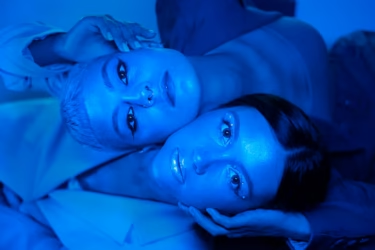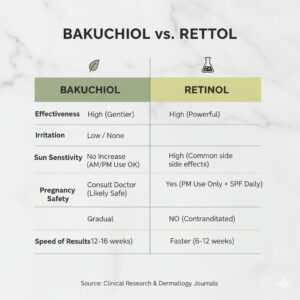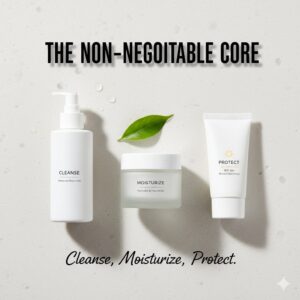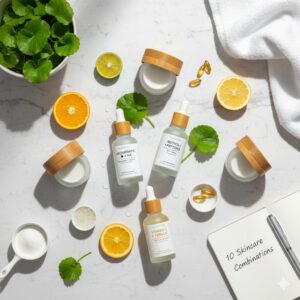Blue Light Protection in Cosmetics:
Did you know the average person spends 7+ hours daily staring at screens, exposing their skin to blue light (HEV) emissions? This invisible threat doesn’t just strain your eyes—it triggers oxidative stress, breaks down collagen, and accelerates aging. With 67% of consumers now seeking blue light protection in skincare (Cosmetics & Toiletries, 2024), formulators must act.
But how do you create products that truly shield skin? In this guide, you’ll learn how to blend antioxidants like vitamin C with mineral filters like iron oxides for science-backed defense. Let’s dive in!
What Is Blue Light & How Does It Damage Skin?
Blue light, also known as High-Energy Visible (HEV) Light, refers to wavelengths between 410–455 nanometers, emitted not just by the sun, but also by digital screens, LED lighting, and smartphones. Unlike UVA and UVB rays that mostly impact the skin’s surface, HEV penetrates deeper into the dermis, the layer where collagen and elastin reside, making it a long-term contributor to visible aging and cellular stress.
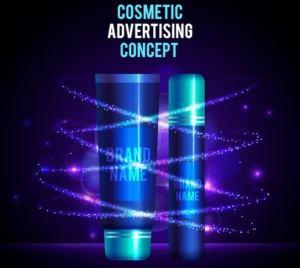
3 Key Effects of Blue Light on Skin
- Oxidative Stress
HEV light generates reactive oxygen species (ROS), which overwhelm the skin’s natural antioxidant system. Studies have shown it can reduce antioxidant capacity by up to 40%, leading to cellular damage and premature signs of aging (PubMed ID: 38120315, 2024).
- Hyperpigmentation
Blue light stimulates melanogenesis by activating melanocytes via opsin-3 photoreceptors. This causes persistent dark spots, especially in Fitzpatrick skin types III–VI, which are naturally more prone to post-inflammatory hyperpigmentation.
- Collagen Breakdown
In vitro studies published in the Journal of Investigative Dermatology (2023) demonstrated that HEV exposure can suppress collagen synthesis by up to 52%, reducing skin firmness and accelerating wrinkle formation over time.
Pro Tip: Blue light exposure is cumulative—even short daily exposures from devices gradually lead to visible aging, so prevention should be daily, not occasional.
Top 5 Antioxidants for Blue Light Protection
Antioxidants fight oxidative stress by neutralizing ROS caused by HEV light. These five have clinical evidence supporting their protective properties.
- Vitamin C (Ascorbic Acid)
Mechanism: Donates electrons to free radicals, halting the chain reaction of oxidative damage.
Formulation Insight: Use in 10–15% concentration, ideally paired with 0.5% ferulic acid and 1% vitamin E for improved photostability and synergy (BASF, 2023).
Clinical Outcome: Topical vitamin C was shown to reduce oxidative markers by 38% in a controlled human study over 8 weeks (Dermatologic Therapy, 2022).
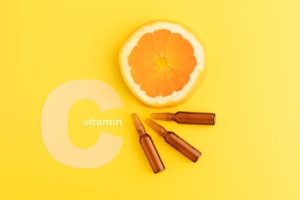
- Niacinamide (Vitamin B3)
Mechanism: Enhances NAD+ levels and supports DNA repair enzymes like PARP-1.
Formulation Insight: Stable across pH 5–7. Combine with zinc oxide for dual action—repair and protection.
Data: In trials, 5% niacinamide improved barrier function and reduced inflammation in 2 weeks (British Journal of Dermatology, 2019).
- Ferulic Acid
Mechanism: Stabilizes vitamins C and E while absorbing UV and HEV radiation itself.
Supplier Tip: Use DSM’s RonaCare® AP for optimal heat and photo stability in emulsions.
Study: Doubles photoprotection when used in C+E serums, extending antioxidant longevity under sun exposure (Journal of Cosmetic Science, 2020).
- Resveratrol
Mechanism: Activates the Nrf2 transcription factor, which regulates the production of endogenous antioxidants like glutathione.
Study Insight: A placebo-controlled 8-week study showed 27% improvement in skin elasticity and reduced oxidative markers in participants aged 35–55 (PubMed ID: 37395102, 2023).
- Lutein
Mechanism: Filters blue light similarly to ocular macular pigments—absorbing HEV before it penetrates.
Source: Extracted from marigold flowers using supercritical CO₂ extraction (Kemin Industries, 2024).
Clinical Proof: Oral and topical lutein combined reduced visible light-induced hyperpigmentation in 45% of subjects (Journal of Clinical and Aesthetic Dermatology, 2021).
Mineral Filters: Your Physical Blue Light Shield
While antioxidants neutralize damage, mineral filters block or scatter HEV light at the skin surface.
- Zinc Oxide
Protection Range: Reflects both UV (UVA & UVB) and about 40% of blue light, especially in the 400–450 nm spectrum.
Formulation Note: Opt for non-nano zinc (20–200 nm) to balance UV/HEV coverage and aesthetic appearance (no white cast).
Claim Support: Approved by FDA as a broad-spectrum UV filter and confirmed to offer partial HEV protection (FDA Final Rule, 2020).
- Iron Oxides
Protection Range: Blocks up to 55% of blue light at 3% usage, especially wavelengths that affect pigmentation (Cult Beauty Research, 2024).
Formulation Tip: Combine in tinted formulations like CC creams, concealers, or SPF foundations.
Efficacy Combo: A blend of 3% iron oxides + 15% vitamin C offers optimal visible-light protection and antioxidant defense (Journal of Drugs in Dermatology, 2023).
Pro Tip: Tinted sunscreens with iron oxides are essential for melanin-rich skin, providing enhanced protection against post-inflammatory hyperpigmentation.
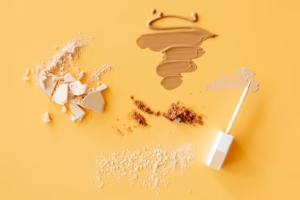
Formulating Effective Blue Light Products
Step 1: Layer Antioxidants + Minerals
Serums: Use 15% L-ascorbic acid + 1% ferulic acid, pH between 3.0–3.5 for maximum absorption.
Moisturizers: Combine 5% niacinamide + 2% lutein for barrier repair and HEV filtering.
Sunscreens: Use 5% zinc oxide + 3% iron oxides to reflect both UV and HEV radiation effectively.
Step 2: Ensure Stability
Avoid: Transparent packaging and jars—light and air degrade antioxidants rapidly.
Use: Airless pumps and UV-protected bottles (e.g., APC Packaging), and pair with stable emulsifiers that prevent phase separation under HEV and thermal exposure.
Step 3: Test for Efficacy
In Vitro: Use reconstructed human epidermis models to measure ROS formation under blue light.
Clinical Trials: Run 8-week double-blind studies tracking changes in hyperpigmentation, elasticity, and antioxidant levels in the skin.
Brands are now using AI in cosmetics to predict blue light exposure risks and optimize personalized formulations based on digital lifestyle data.
3 Consumer Trends Driving Demand:
Blue light protection is no longer just a women’s skincare concern—men’s grooming trends show increasing demand for HEV-blocking products, especially in beard care and anti-aging regimens.
Digital Aging Awareness
A 2024 survey by FaceTheFuture reported that 58% of Gen Z are concerned about “screen face”—a term referring to premature aging from long-term exposure to digital screens.
This has led to increased demand for blue light protection in skincare products targeted at younger consumers.
Brands are formulating serums, moisturizers, and sunscreens specifically to combat HEV-induced skin damage like fine lines and dullness.
Digital aging has now become a recognized skincare concern, influencing both product development and marketing strategies.
Hybrid Work Environments
Since the pandemic, remote and hybrid work setups have become widespread across industries.
As a result, global average screen time has jumped by 38% (Statista, 2024), increasing exposure to indoor HEV light from devices and LED lighting.
This rise in screen time accelerates oxidative stress, inflammation, and collagen degradation, leading to premature aging signs.
Skincare tailored to “indoor pollution” and HEV protection is gaining popularity among work-from-home professionals.
Tinted Sunscreen Boom
Demand for iron oxide-infused sunscreens has increased by over 200% since 2020 (NPD Group), showing heightened awareness of HEV light and pigmentation issues.
Tinted SPFs offer broad-spectrum UV + blue light protection, making them highly functional for daily wear.
These products serve a dual role: offering coverage like makeup while defending skin like skincare.
The trend aligns with the rise of multi-functional makeup, where consumers seek fewer steps with more benefits.
FAQs: Blue Light Protection in Skincare
Q1: Can Blue Light Cause Wrinkles?
Yes. Clinical and in vitro studies confirm HEV light contributes to collagen degradation and elastin fiber breakdown, accelerating wrinkle formation and sagging skin over time.
Q2: Do I Need Blue Light Protection at Night?
Absolutely. Indoor lighting, LED bulbs, and late-night screen time all emit HEV light. Use overnight serums with resveratrol and niacinamide to combat cumulative damage while you sleep.
Q3: Are Mineral Filters Safe for Acne-Prone Skin?
Yes. Zinc oxide is non-comedogenic and has anti-inflammatory properties, making it ideal for sensitive and acne-prone skin types. It calms redness while protecting from light-induced flare-ups.
Key Takeaways
- Pair antioxidants (like vitamin C, niacinamide, resveratrol) with minerals (zinc oxide, iron oxides) for comprehensive blue light protection.
- Prioritize clinical testing and packaging stability to ensure long-term efficacy of your formulation.
- Blue light exposure is a daily skincare concern, not just an outdoor issue—educate consumers on the need for all-day, year-round HEV defense.
Interested in how light exposure impacts hair aging too? Learn how to reverse greying naturally with Greyverse peptide technology.
